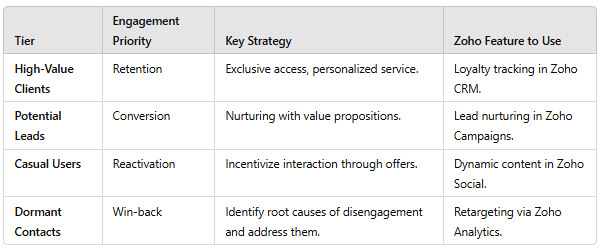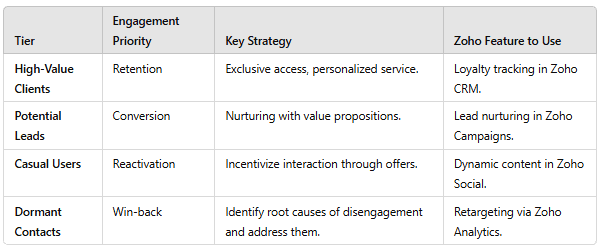Audience tier funneling is a robust methodology for categorizing audiences into distinct tiers and tailoring interactions based on their needs, potential, and engagement level. Leveraging Zoho’s ecosystem of tools, businesses can streamline this process, driving growth with targeted strategies and measurable outcomes.
One of the most difficult challenges businesses face is guiding a customer through the buyer's journey to the end goal of making a purchase. Getting people to engage and generate leads may appear simple enough, but converting those leads into sales is often far more difficult. Audience prospecting techniques are methods salespeople use to identify leads, qualify them, and establish contact. The results of your sales process are a direct function of the quality of your sales prospecting methods. Sales conversion rate is a good metric to track in your sales dashboard to learn the answers to these questions because it shows you how quickly you convert leads into customers.
What Is Audience Tier Funneling?
Audience tier funneling involves dividing your audience into categories (tiers) based on their behaviors, value, or stage in the customer journey. These tiers are often:
- High-Value Clients – Long-term loyal customers or high-revenue clients.
- Potential Leads – Those actively engaging but not yet converted.
- Casual Users – Those with sporadic engagement.
- Dormant Contacts – Previously engaged individuals who are now inactive.
By using data-driven tools like Zoho, businesses can implement strategies to engage each tier effectively, ensuring optimized ROI and sustained growth. As the sales process evolves and conversations become more buyer-focused, sales representatives have developed effective methods for navigating the sales pipeline. A good sales prospecting process makes it much easier to create effective frameworks that can be used repeatedly, giving you a better chance of closing the deal with your prospects.
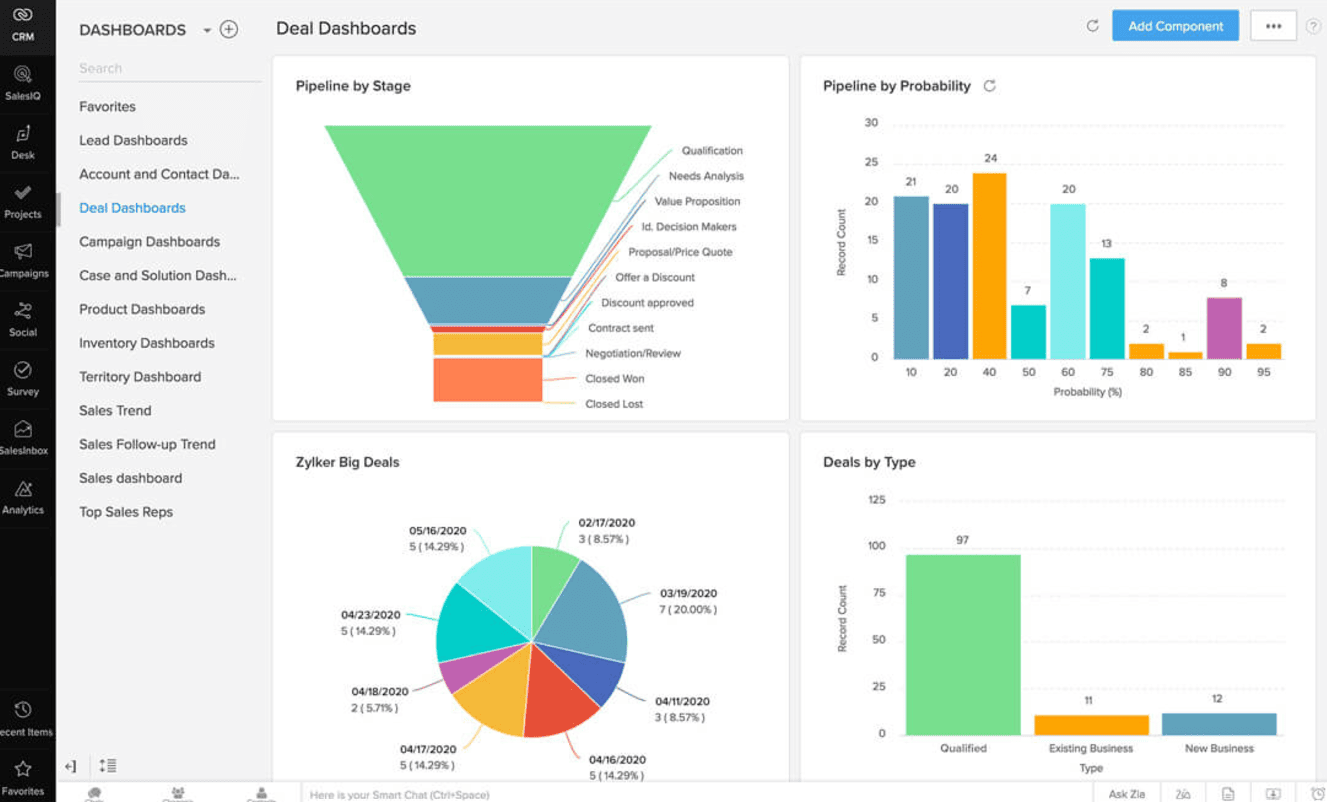
An example dashboard by Zoho Solutions providing with an illustration on how 'deals', 'product activity', 'territory', 'follow-up trend', 'leads', 'account activity' and other factors can be catered to in separate dedicated dashboards or mixed together as needed, to dissect on aspects for impact bearing actions among operations within a business!
What are the benefits of Audience Prospecting?
Prospecting is an important first step in the sales success journey because it opens up a world of new opportunities for both sales professionals and their potential leads. It enables sales representatives to increase sales by offering their product or service to qualified customers who are attempting to overcome specific challenges.
Prospecting success can lead to the following outcomes:
- Personalized targeting: Prospecting gives you complete control over lead generation by allowing you to analyze which sources and channels produce the best results. It also assists you in fine-tuning your lead prospecting in order to select and collect those who have the greatest potential to become customers.
- More customers: More customers lead to more revenue, as each new prospect you find and convert to a buyer increases sales in your business. This growth helps companies grow over time while also helping to offset risks of increased operations and costs of goods from inflation.
- Gathering of information: Prospecting does not always result in immediate sales, but as you reach out to more people and observe how they respond, you'll begin to notice patterns in their behavior. Market research can be a useful tool for determining why customers enter the market to buy specific products and how to best sell them. These insights can assist sales representatives in targeting and contacting specific prospects while also improving their long-term strategies.
- Improved conversion rates: Using your time wisely when targeting leads can result in a higher conversion rate. Cold outbound prospecting can even outperform warm lead prospecting in terms of conversion rate, but only when done correctly. As a result, it's critical to be mindful of your targeting—that is, to prioritize quality over quantity.
Prominent Audience Prospecting Methods
- Identify former customers for potential prospects: The former and prospective customer is a wonderful thing. For starters, they are already familiar with your product or service and were sufficiently impressed with it to become an adopter at some point. While customers leave for a variety of reasons, there is no rule that says you can't bring them back when their needs align or your offering evolves to meet their needs. Reaching out to former customers in a friendly manner may spark a conversation and result in a sale. This is a great supplement to your referral request strategy.
- Segmented and personalized campaigns at each online channel: Personalized emails are another effective way to contact prospects. Many people dislike being put on the spot, and email allows them to read your content whenever they want, do their own research at their leisure, and pull the trigger only when they're ready. Emails also save you time because you can send thousands of them at once or schedule them based on your leads' time zone or activity. Overall, email marketing also helps you strengthen your relationship with your prospects by naturally leading them further down the sales funnel.
- Follow-up automations, re-targeting Campaigns and/or re-activations to pursue qualified leads: Getting quality leads in the door requires thorough research. Part of this research entails eliminating prospects who, for one reason or another, may be a good initial fit but fall short in one or more qualification areas. Taking care of these early qualifications ensures that the leads you pursue have the best chance of turning into closed deals.
- Use media and channel analytics: With the rise of mutli-media channels online, marketers now have unprecedented access to their target audience. Scanning social media platforms for relevant data on a regular basis can yield a variety of information, including topics of interest to your audience, industry changes and advancements, high-profile industry professionals making moves, and sentiment data for yourself and your competitors.
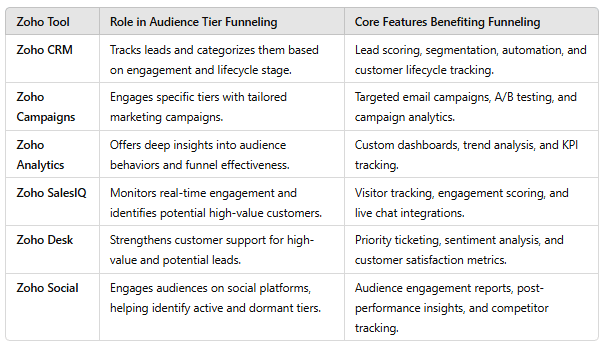
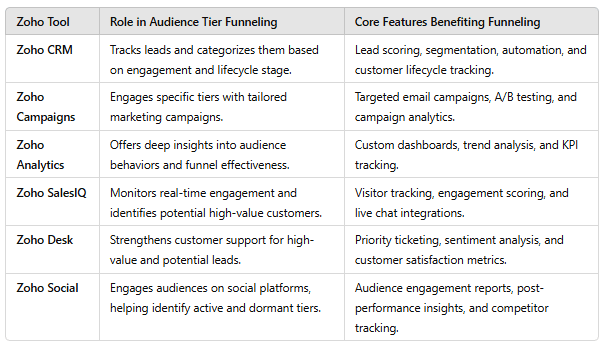
Implement Audience Tier Funneling with Zoho
1. Define and Segment Tiers in Zoho CRM
- Use Zoho CRM’s segmentation tools to categorize audiences.
- Criteria include: revenue potential, engagement score, purchase frequency, and lifecycle stage.
Example:
- High-Value Clients: Lifetime revenue > $10,000 and regular engagement.
- Potential Leads: Engagement score > 75 but no purchase.
- Dormant Contacts: No activity in the last 6 months.
2. Automate Engagement with Zoho Campaigns
- Create automated workflows targeting each tier.
- Use dynamic content to personalize email campaigns based on tier.
Example:
- High-value clients receive loyalty programs or exclusive offers.
- Potential leads get nurturing campaigns emphasizing benefits.
3. Analyze Funnel Performance Using Zoho Analytics
- Build dashboards tracking KPIs like conversion rates, engagement scores, and tier movement.
- Identify bottlenecks in the funnel, such as low conversion of potential leads.
4. Leverage Real-Time Data from Zoho SalesIQ
- Monitor visitor activity on your website to identify and engage potential leads.
- Automate live chat triggers for high-scoring visitors.
5. Close the Loop with Zoho Desk
- Prioritize support for high-value clients to improve retention.
- Analyze dormant client tickets for common issues causing disengagement.
Comparison of Tiers and Key Engagement Strategies
